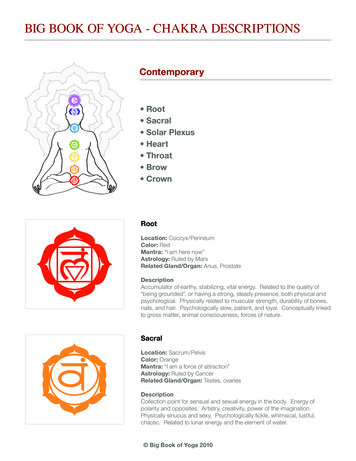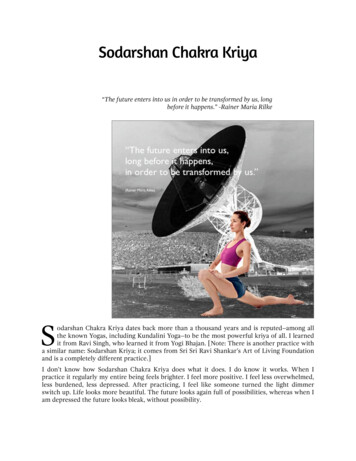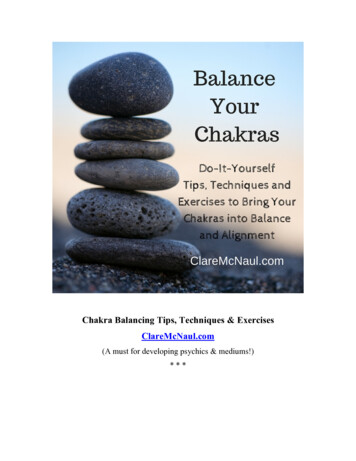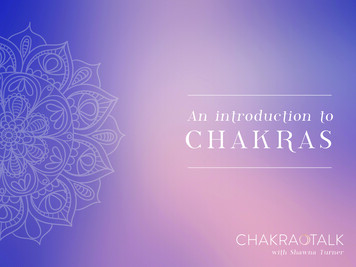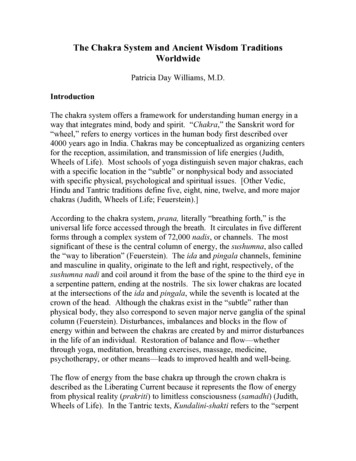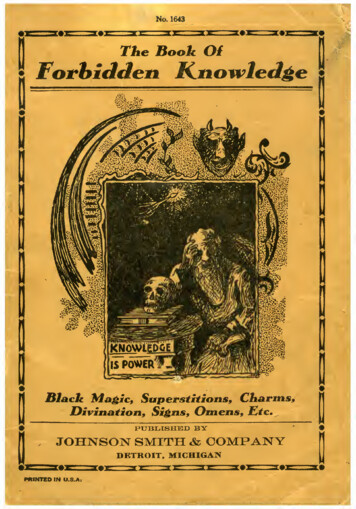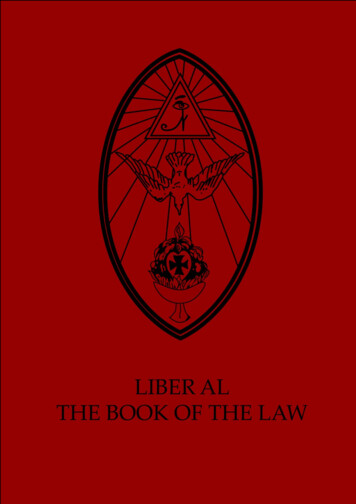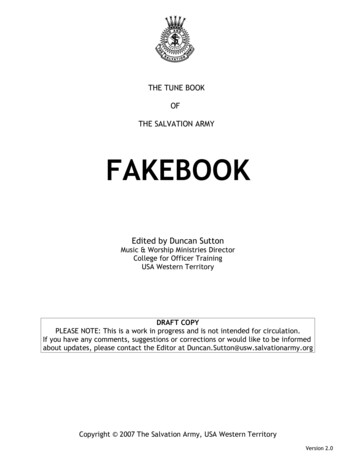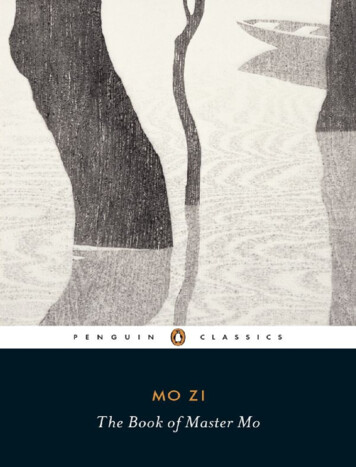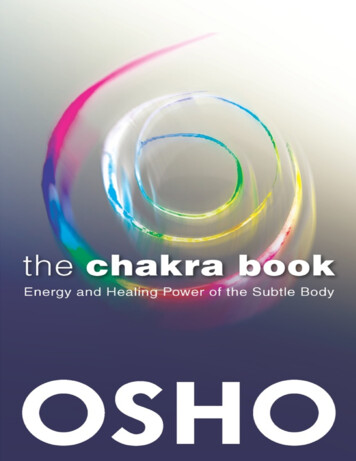
Transcription
The Chakra BookEnergy and Healing Power of the Subtle BodyOSHO
Copyright 1999, 2015 OSHO International Foundationwww.osho.com/copyrightsImages and cover design OSHO International FoundationAll rights reserved. No part of this book may be reproduced or transmitted in any form or by any means,electronic or mechanical, including photocopying, recording, or by any information storage and retrievalsystem, without prior written permission from the publisher.The Chakra Book is also available as a print edition ISBN 978-1-938755-95-8The text excerpts in this book are selected from various talks by Osho, given to a live audience. All ofOsho’s talks have been published in full as books, and are also available as original audio recordings. Audiorecordings and the complete text archive can be found via the online OSHO Library atwww.osho.com/libraryOSHO is a registered trademark of OSHO International Foundationwww.osho.com/trademarksPublished byOSHO MEDIA INTERNATIONALis an imprint ofOSHO INTERNATIONALNew York – Zurich – Mumbaiwww.osho.com/oshointernationalLibrary of Congress Catalog-In-Publication Data is availableeBook ISBN: 978-0-88050-994-7
IntroductionOsho,Is knowledge about esoteric subjects such as chakras, collective unconsciousness, energyfields, really helpful along the way, or not? Or will whatever is needed come to me throughexperience, in its own time?Anything that is needed will come of its own accord, in its own time. Allthis so-called esoteric knowledge about chakras, energy fields, kundalini, astralbodies, is dangerous as knowledge. As an experience, it is a totally differentthing. Don’t acquire it as knowledge. If it is needed for your spiritual growth, itwill come to you in its right time, and then it will be an experience.If you have an acquired knowledge, borrowed knowledge, it is going to be ahindrance. For example Hindu Yoga believes in seven chakras, Jaina scripturesmention nine chakras, and Buddhist scriptures say that there are dozens ofchakras and that these are only the important ones which have been chosen bydifferent schools. They don’t give any fixed number. Acquired knowledge willbe confusing: How many chakras? And what are you going to do with thatknowledge, whether there are seven or nine or dozens? Your knowledge is notgoing to help; it can only hinder.My own experience is that perhaps Buddha’s experience is correct – and thatdoes not make the Hindu Yoga or Jaina Yoga incorrect. Buddha is saying thatthere are energy fields, whirling energy fields, from the lowest point in yourspine up to the very peak of your head. There are many; now it is only aquestion of a particular teaching which ones are important for it. That particularteaching will choose those. Hindus have chosen seven, Jainas have chosennine. They don’t contradict each other, it is simply that the emphasis is onwhatever chakra the teaching feels to emphasize.As far as I am concerned, you will come across only four chakras which arethe most important.One you know is your sex center. The second, just above it, which is notrecognized in any Indian school of thought but has been recognized in Japanalone, is called the hara. It is between your navel and the sex center. The hara isthe death chakra.My own experience is that life, that is the sex center, and death, that is thehara, should be very close, and they are.In Japan, when somebody commits suicide, it is called hara-kiri. Nowhere inthe world does such a thing happen except in Japan. Suicide is committedeverywhere, but with a knife? Just two inches below the navel, the Japanese
forces a knife – and this is the most miraculous death; no blood, no pain – anddeath is instantaneous.So the first chakra is the life chakra; it is a whirling energy. Chakra meanswheel, moving. Just above the life chakra is the death chakra.The third important chakra is the heart chakra. You can call it the lovechakra, because between life and death the most important thing that canhappen to a man or to a woman is love. And love has many manifestations:meditation is one of the manifestations of love, prayer is one of themanifestations of love. This is the third important chakra.The fourth important chakra is what Hindu Yoga calls the agna chakra – juston your forehead between the two eyes. These four chakras are the mostimportant.The fourth is from where your energy moves beyond humanity into divinity.There is one more chakra, which is at the top part of your head, but you willnot come across it in your life journey. That’s why I am not counting it. Afterthe fourth, you have transcended the body, the mind, the heart, all that is notyou – only your being remains. And when death happens to such a person That’s why in India the hara has not been taken note of; in the Hindu orJaina or Buddhist Yoga, they were not considering people who commit suicide.They were thinking about people who were transforming their energy from thephysical to the immaterial.So the fifth chakra is the sahasrar. The Jainas count it, the Hindus count it –because a person who dies after transcending the fourth chakra His energy,his being leaves the body, cracking the skull into two parts; that is the sahasrarchakra, but because it is not part of your life experience, I am not counting it.The four are your life experience. This one is the death of a person who isenlightened. He does not die from the hara.That’s why in India no school has taken note of the hara chakra. But inJapan they had to take note of it, because in Japan suicide was a form ofetiquette.You will be puzzled: the Japanese have such a totally different culture fromthe whole world; from small things to big things, they have their own approach.I am reminded of one incident. A Japanese can commit suicide for smallthings because he cannot live a life of shame. If he feels ashamed, that isenough to finish his life – and you will not be able to conceive of what smallthings are thought so important that life is nothing.A master, who was the greatest archer of Japan, was called by the king. Theking wanted his son to become as great an archer as the master.
Now, it is Japanese etiquette that even when two people are going to fightwith each other, first they will bow down to each other’s divinity with foldedhands, even though they are going to kill. Before killing, they will respect eachother. So in ordinary life in Japan, you will find people everywhere bowingdown to each other – on the road, in the restaurants. It is disappearing, as themodern Western influence is changing the whole world.But the master archer was such an egoist that even in front of the king hewaited: first the king should fold his hands, and then The king’s court condemned the man and said, “You have committed such ashameful act. Just go back and commit hara-kiri.” It was not such a big thing,but when the whole court had said it, the whole country would know about it.The man went directly to his home and committed hara-kiri.He had three hundred students. When they heard that their master hadcommitted a shameful act, all three hundred students committed hara-kiribecause it was so shameful that their master should have behaved like this.Now this cannot happen anywhere else in the world. If the master had donesomething shameful – although it was not much of a shameful act, but even if itwere, the students were completely innocent. But because they were thestudents of that master, it was enough to feel ashamed – they had followed sucha man.People have been committing hara-kiri in Japan for centuries. So whenBuddhism reached there for the first time, about fourteen hundred years ago,and they started meditating, they were the first people to discover the haracenter – because they had been using that center for centuries, so it wasthrobbing and vibrating and alive.It all depends. In different cultures it may be a little different where thecenter is.For example when Japanese started coming to me for sannyas, I was a littlebit puzzled – because all over the whole world when you want to say yes, youmove your head up and down. And the Japanese, when they want to say yes,move the head from side to side – which means no. All over the world, that isthe sign for no – but that is their sign for yes, and the head moving up anddown is their sign for no.So when I would ask them something I would be very puzzled; I could notbelieve that they had come to take sannyas. They were sitting before me and Iwas asking, “Are you ready for sannyas?” and they would shake their heads.“Then why have you come? You have unnecessarily traveled here from Japanand you are sitting here in front of me just for that purpose, and you are saying
no?”Then my interpreter said to me, “You don’t understand; that person is sayingyes. In Japan, the head moving from side to side is yes; the head moving upand down is no.” So you have to remember it when you are talking with theJapanese. Otherwise there is going to be great confusion – you will saysomething, they will understand something else. They cannot speak but theycan understand.In the Caucasus, where Gurdjieff was born, they have a system of chakraswhich is slightly different. It seems to be the difference between the people ofthe Caucasus and other people.In India, three religions, Hinduism, Jainism and Buddhism, all have exactlythe same points. They may count five or seven or nine, but the places areexactly the same. The centuries have affected their bodies in a different way.In the Caucasus, there are thousands of people who are older than a hundredand fifty years. The Caucasus is the place with the oldest people in the wholeworld – and they are not old; at the age of one hundred and eighty, a person isstill young. He is working on the farm just like any young man.In the Caucasus, people always die while very young; they don’t grow old.Naturally their bodies have developed in a different way. Their food hassomething to do with it, the climate, the geography, their land. It has created adifferent psychology.Throughout the whole world, it is thought that seventy years is the time foreverybody to die – that is the average; you can be five years earlier or fiveyears later, but the average is seventy.When George Bernard Shaw became seventy, he started looking in the smallvillages around London at the gravestones in their cemeteries, to see how longpeople in that village had lived. His friend said, “You are mad. Why are youwasting your time?”He said, “I don’t want to die at seventy. I have never been average inanything, and I cannot be average in death. So I am looking for a place wherepeople don’t believe that seventy is the average age to die, because that placewill have a psychology of its own.”Finally he found a village where, on many stones in the graveyard, he foundthat it was written: This man lived one hundred and eight years, and dieduntimely.He said, “This is the right place – where a man lives one hundred and eightyears and still people think the poor fellow has died untimely, that it was notyet time to die.”
After seventy years he moved from London – he had lived there for seventyyears – to a village, after checking the cemetery. And he lived a hundred years.He proved that village had the psychology, that village had the vibe, thatvillage had the idea that one hundred years is nothing.When he would ask people if he could live to one hundred, they would say,“One hundred is nothing; everybody lives to one hundred. You can go to thecemetery and see – one hundred and forty, one hundred and thirty; people livethat long very easily. A hundred? – that is too early.”He lived one hundred years.Certainly he proved one fact: that your psychology, your mind, your body,are impressed by the vibrations in which you live.So you will come to experience chakras, you will come to experience energyfields, but it is better not to be knowledgeable because that is a difficultproblem. You may read a book written five thousand years ago by a certainkind of person and you may not be of the same category. You may not find thatchakra at the same place, and you will feel unnecessarily frustrated. And youwill find a chakra in a place where the books don’t mention it; then you willfeel that you are abnormal, something is wrong with you. Nothing is wrongwith you.Energy fields, chakras, and all the esoteric things should be experienced.And keep your mind clean of all knowledge so that you don’t have anyexpectation; wherever the experience happens, you are ready to accept it.Each individual has differences, and differences come in such small thingsthat you cannot conceive. For example, in the East, people sit on the floor. Incold countries, people cannot sit on the floor; a chair is absolutely necessary.Naturally their backbones, their spines will have a different shape than those ofthe people who sit on the floor, and their experiences of their kundalini will bedifferent.There are people who eat only once a day. For thousands of years they havenever eaten more often than that. In South Africa there are tribes which eatonly once in twenty-four hours. When they came across Americanmissionaries, there was such laughter. “These idiots are eating five times a day!Breakfast – there is no fast at all and they are having ‘break-fast.’ And thewhole day, something or other; and then coffee break, and tea break, and theygo on And in between they are chewing gum. These people have come toteach us religion and they are simply mad!”In a way they are right, because they have beautiful bodies, they live longer,their bodies are not fat. Their bodies are like a deer’s; they can run like deer –
they have to because they are hunters. Their eyes are very clear, veryperceptive; their bodies are very proportionate.Now these people will have a totally different experience of theirphysiology. The meat eaters and the vegetarians will find differences to oneanother.So it is better not to memorize from scriptures. Those scriptures
The text excerpts in this book are selected from various talks by Osho, given to a live audience. All of All of Osho’s talks have been published in full as books, and are also available as original audio recordings.
